Voluntary fasting: what ended the Minnesota experiment, 1944
By Pictolic https://pictolic.com/article/voluntary-fasting-what-ended-the-minnesota-experiment-1944.htmlDuring the Second world war, the people, surprisingly, was killed EN masse not from bullets and shells. They waited for one of the worst fates that only you can imagine — starvation. The reason for this was an acute shortage of food due to destroyed crops and disrupted lines of the food supply.
During the siege of Leningrad daily from lack of food perished more than a thousand people. However, the famine in those days was observed in the most unexpected places — for example, in the city of Minneapolis (Minnesota). In 1944, 36 young men took part in a "starvation" experiment, which was conducted by Dr. Ancel Keys (Ancel Keys).
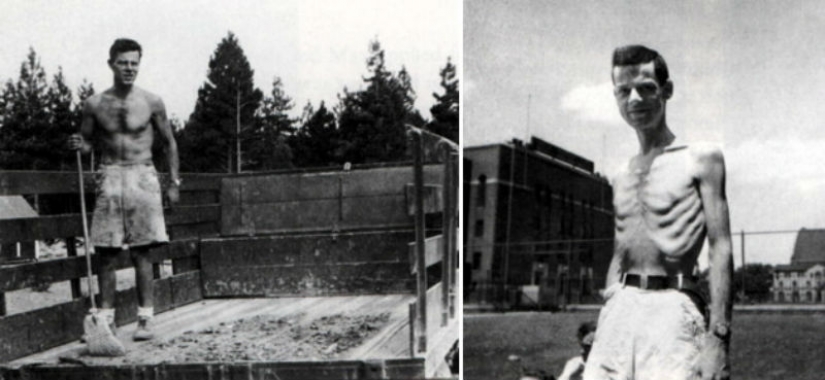
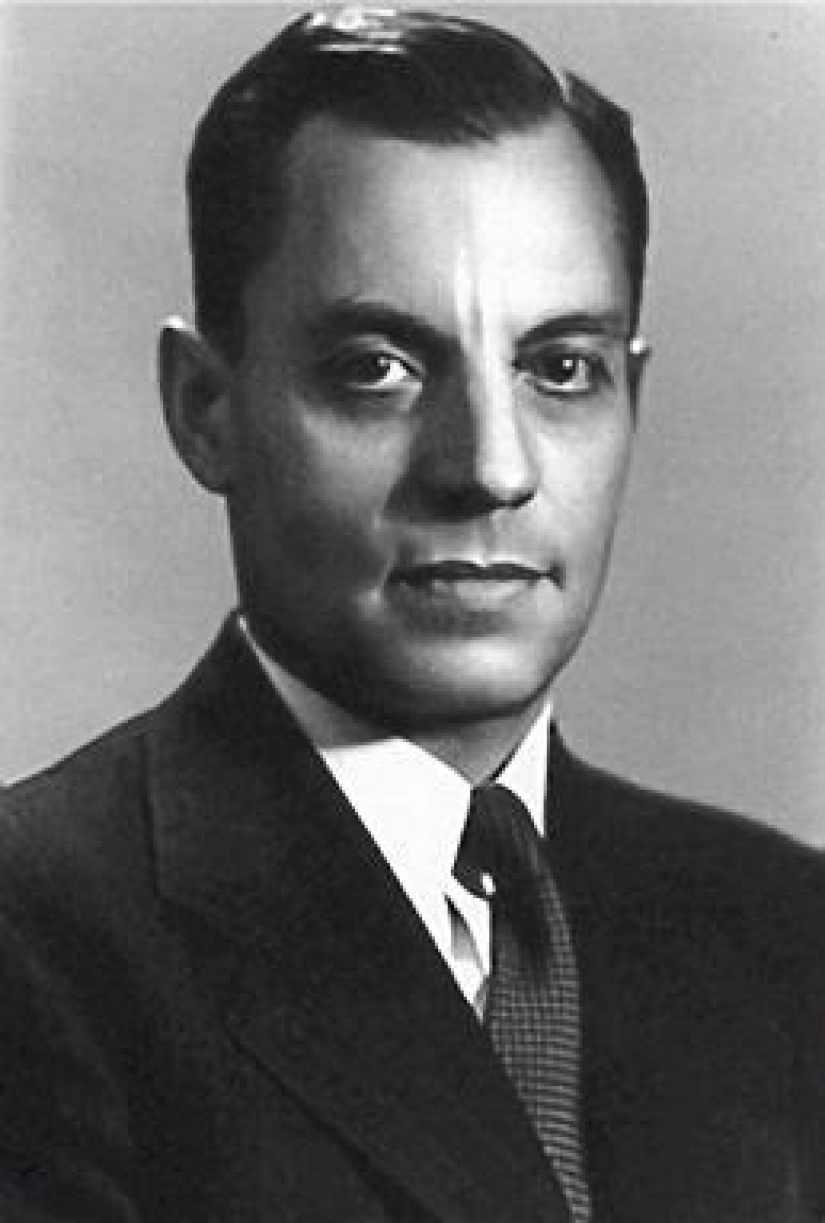
The purpose of the experiment
Ancel Keys was in charge of the Laboratory of physiological hygiene at the University of Minnesota. He had already achieved some fame through the creation of dry rations K-rations for us troops.
Ancel Benjamin Keys, born in Colorado, USA, was an American physiologist who studied the influence of diet on health. In particular, he suggested that saturated fatty acids, the fat that enters the body with food, causes cardiovascular heart disease and should be avoided. In addition to the publication of the book "the Biology of human starvation", which still remains the only source on this topic, KIS also studied the origin of cardiovascular diseases and invented two new diet — To-ration (dry rations for the soldiers of world war II, the contained food for three meals: Breakfast, lunch and dinner) and the Mediterranean diet, which he and his wife successfully promoted. In short, science, diet, and health were the main themes of his professional and personal life.
The idea to hold a "hungry" experiment arose due to the increased interest in the kitty to nutrition. Despite the fact that in Europe, from hunger affects millions of people in the world there were very few doctors who are really able to help them to overcome the effects of exhaustion after the war, because at that time there was practically no any scientific information on this issue. KIS convinced the military that his research will bring huge benefits: receive practical and effective methods of rehabilitation will improve the health of the population and to establish democracy in postwar Europe.
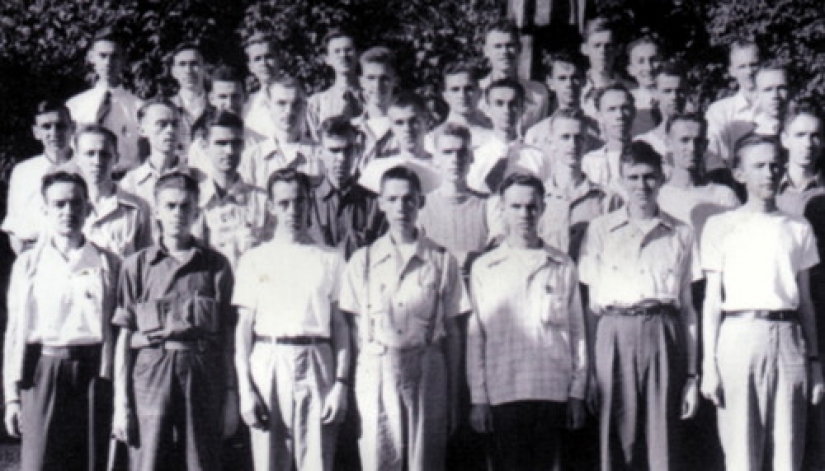 Group photo of the participants of the Minnesota experiment
Group photo of the participants of the Minnesota experiment
The course of the study
Research plan Ansel kitty was very simple: the first to bring the subjects to a state close to exhaustion, and then return them to normal power mode.
To go in a controlled, scientific manner, "hungry" experiment, which was to last a year, Keith was divided into three parts: the first three months of the monitoring period (normal power mode, the same for all subjects), following six months of starvation, the last three months of rehabilitation.
Assistants kitty prepared for these young people a special brochure that was appealing to their idealism. They were shown three small children, sad eyes looking at the empty plates. The inscription at the bottom reads: "are you Willing to starve in order to be better fed?"
 The trick worked. KIS promised volunteers of money and warned them of the serious consequences of prolonged fasting, however, despite this, has received more than 400 applications for participation in the experiment. Many objectors were forced to do unskilled work, for example to repair roads in rural areas, and the experiment gave them a chance to do something for the benefit of mankind.
The trick worked. KIS promised volunteers of money and warned them of the serious consequences of prolonged fasting, however, despite this, has received more than 400 applications for participation in the experiment. Many objectors were forced to do unskilled work, for example to repair roads in rural areas, and the experiment gave them a chance to do something for the benefit of mankind.
KIS, carefully examining each of the submitted applications for participation in the experiment, selected 36 young men who appeared to him to be sufficiently tough to withstand a long period of starvation.
In Minneapolis, the subjects arrived in November 1944. They were placed in the large common room, which was located under the University's football stadium, where KIS temporarily moved his lab.
The next twelve weeks monitoring period Keys were engaged in the standardization of the diet of the subjects. They all ate the same and consume 3200 calories per day. Keys at the same time, through various types of tests collected information about the health status of each of the participants in the experiment parameters such as heart size, blood volume, hearing, vision, physical fitness, body fat, and even the number of sperm in semen. Young people demand kitty were active, he worked in the laboratory and walked no less than 22 miles a week.
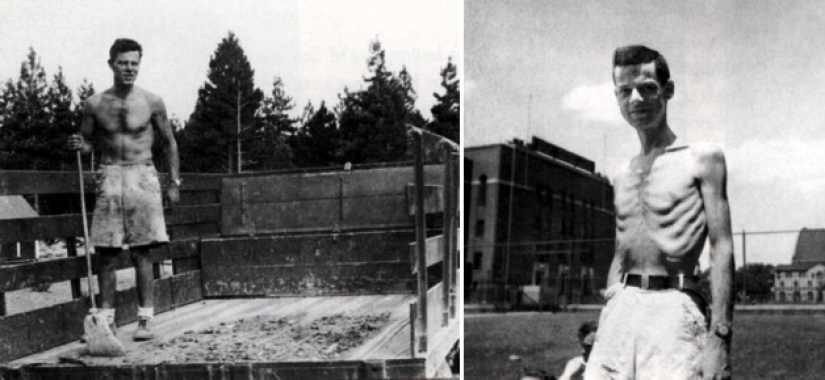 Sam Legge before the start of the experiment (left) and time (right)
Sam Legge before the start of the experiment (left) and time (right)
Starvation and its consequences
12 February 1945 KIS dramatically reduced the diet of the subjects before 1570 calories a day. Entered a phase of starvation. He carefully controlled the amount of food consumed by young people. They ate only twice a day. Meals were prepared mainly from foods rich in carbohydrates. Protein that subjects were less. The emphasis on potatoes, cabbage, pasta and whole grain bread — what mainly ate Europeans during the Second world war. The subjects, despite a decline in calorie consumption, continued to lead an active way of life, including work in the lab and walking.
Effects of changes in diet did not keep itself waiting. Soon the young men began to experience fatigue and energy. They began to complain of lethargy and constant fatigue. KIS noted that the strength they have decreased by 21 percent.
Next, all participants of the experiment was observed mental apathy. Before the young people hotly debated topics such as politics, romance and sex, and now even they have lost them all meaning. Food — that's what worried them the most. Some men were constantly reading cookbooks, considering appetizing pictures in them almost pornographic obsession.
The subjects were often irritability and aggressiveness, and if I was not filed on time, or they had to wait in long queues in the dining room. The dishes were the most common, but young people savored every bite. Sometimes they refilled their food in water to increase its volume and to fool the stomach.
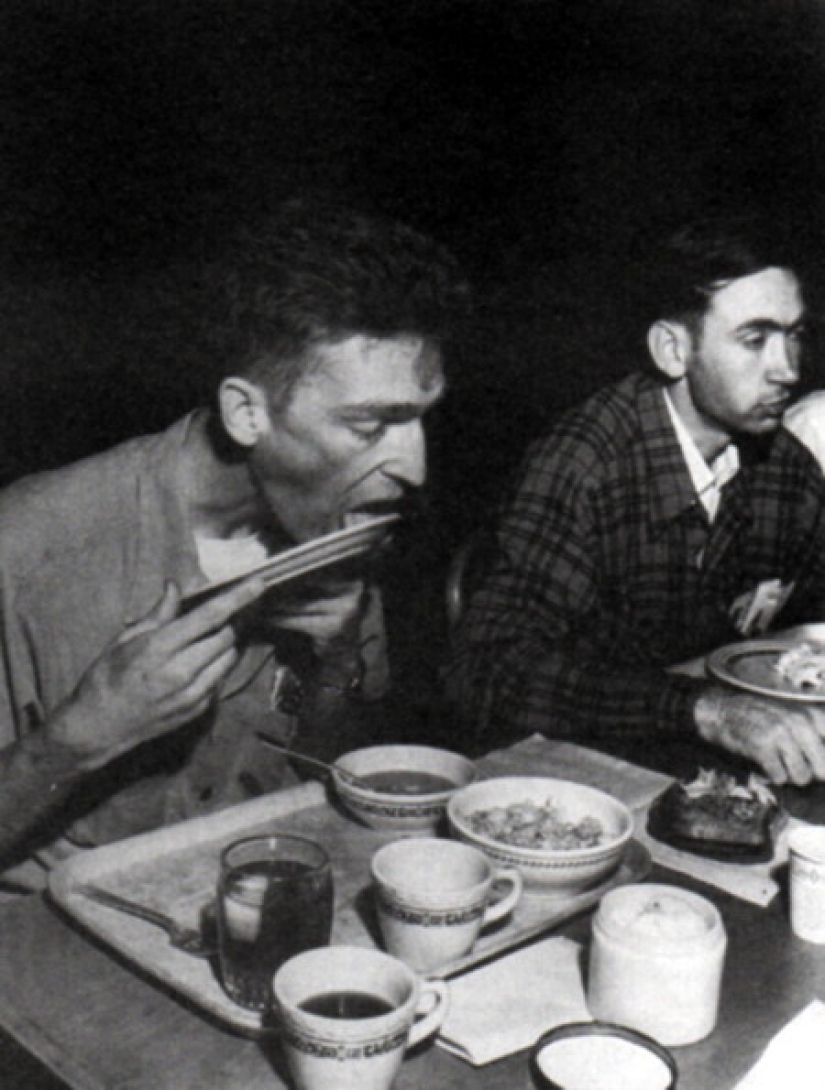 In between the two meals KIS allowed participants unlimited time to chew gum, drink as much as you like, water and black coffee. He noticed that young people were chewing up as much as 40 packs of gum a day and drank 15 cups of coffee.
In between the two meals KIS allowed participants unlimited time to chew gum, drink as much as you like, water and black coffee. He noticed that young people were chewing up as much as 40 packs of gum a day and drank 15 cups of coffee.
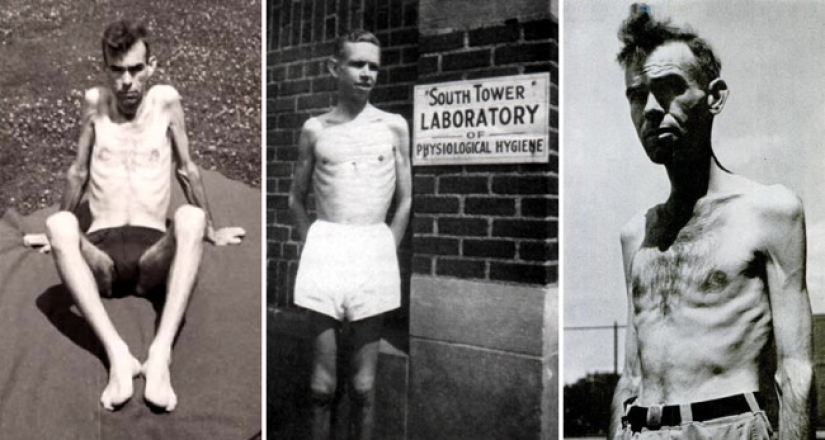 24-year-old Franklin Watkins psychologically worse than the others experienced a period of fasting. He dreamed of disturbing dreams, in which he committed an act of cannibalism, eating the flesh of an elderly man. During trips to the city (before the subjects were put in charge of the guards) Watkins bought milkshakes and ice cream. Ancel Keys learned about it after a while and decided to interview the subjects one-on-one. The young man in conversation with him just burst into tears. Then he had a fit of rage, during which he threatened to kill the kitty, and then — and yourself.
24-year-old Franklin Watkins psychologically worse than the others experienced a period of fasting. He dreamed of disturbing dreams, in which he committed an act of cannibalism, eating the flesh of an elderly man. During trips to the city (before the subjects were put in charge of the guards) Watkins bought milkshakes and ice cream. Ancel Keys learned about it after a while and decided to interview the subjects one-on-one. The young man in conversation with him just burst into tears. Then he had a fit of rage, during which he threatened to kill the kitty, and then — and yourself.
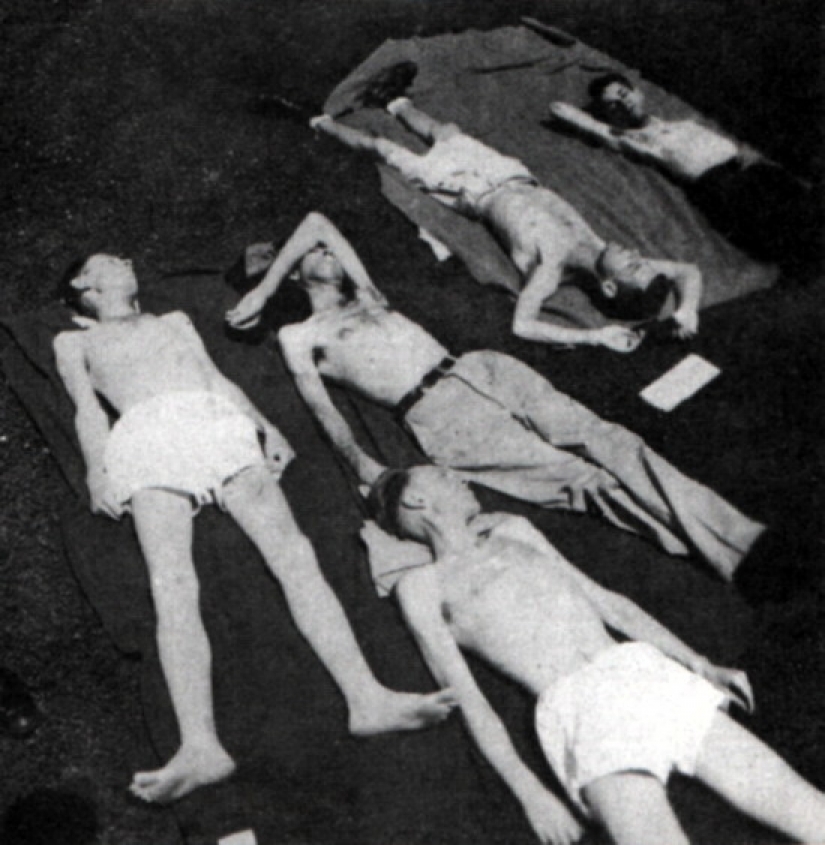 Kitty was forced to send Watkins in the psychiatric ward of the University hospital. A few days later he was released because he returned to a normal diet immediately started coming back to normal. The failure occurred at the young man in just a few weeks after the transition to the stage of starvation.
Kitty was forced to send Watkins in the psychiatric ward of the University hospital. A few days later he was released because he returned to a normal diet immediately started coming back to normal. The failure occurred at the young man in just a few weeks after the transition to the stage of starvation.
Subsequently, the Kitty had the same reason to exclude from the number of participants in the experiment another man.
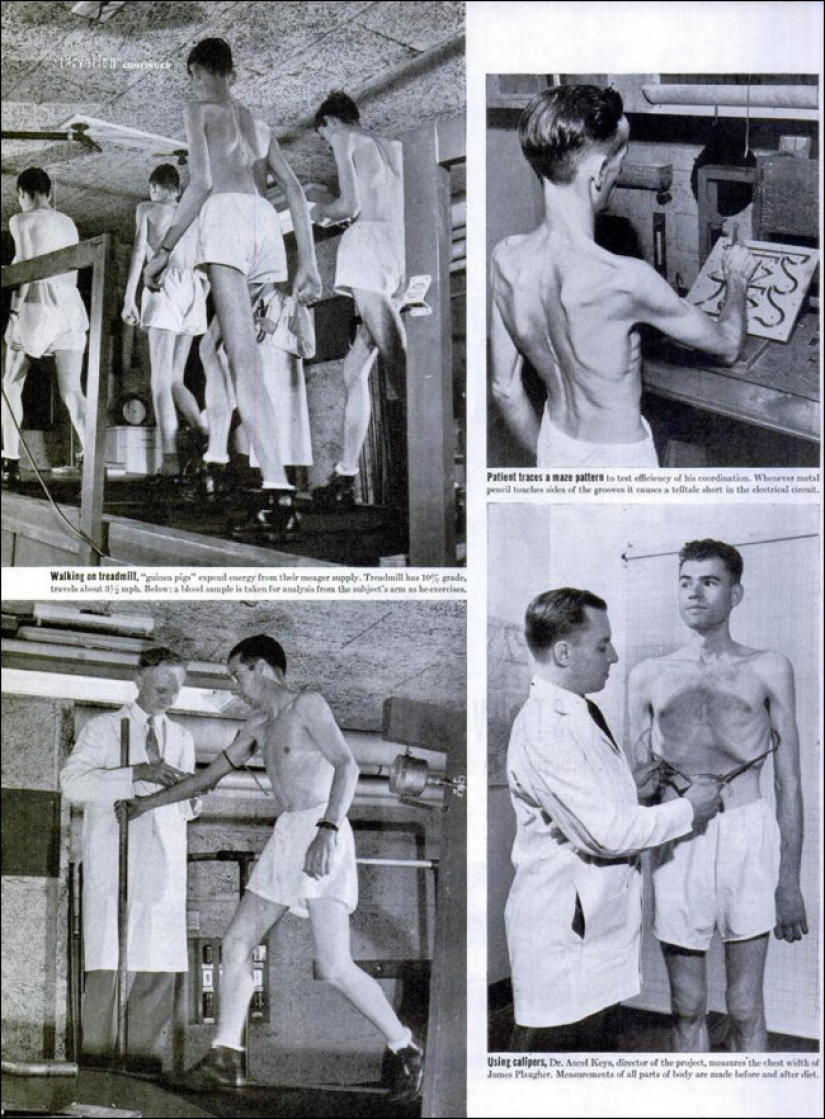 Physiological changes
Physiological changes
All participants initially had normal body weight. During the follow-up period, their average weight was 70 kg. After the beginning of fasting, they began to lose weight rapidly, turning into walking skeletons. Ancel Keys carefully analyzed and documented everything that happens to them physiological changes.
He found that the average heart rate in young people has declined sharply: to fasting was 55 beats per minute, and after only 35. The body due to the caloric deficit switched to "power saving mode", slowing the metabolism. Stool frequency they were once a week. Blood volume was reduced by 10 percent the size of the heart also decreased.
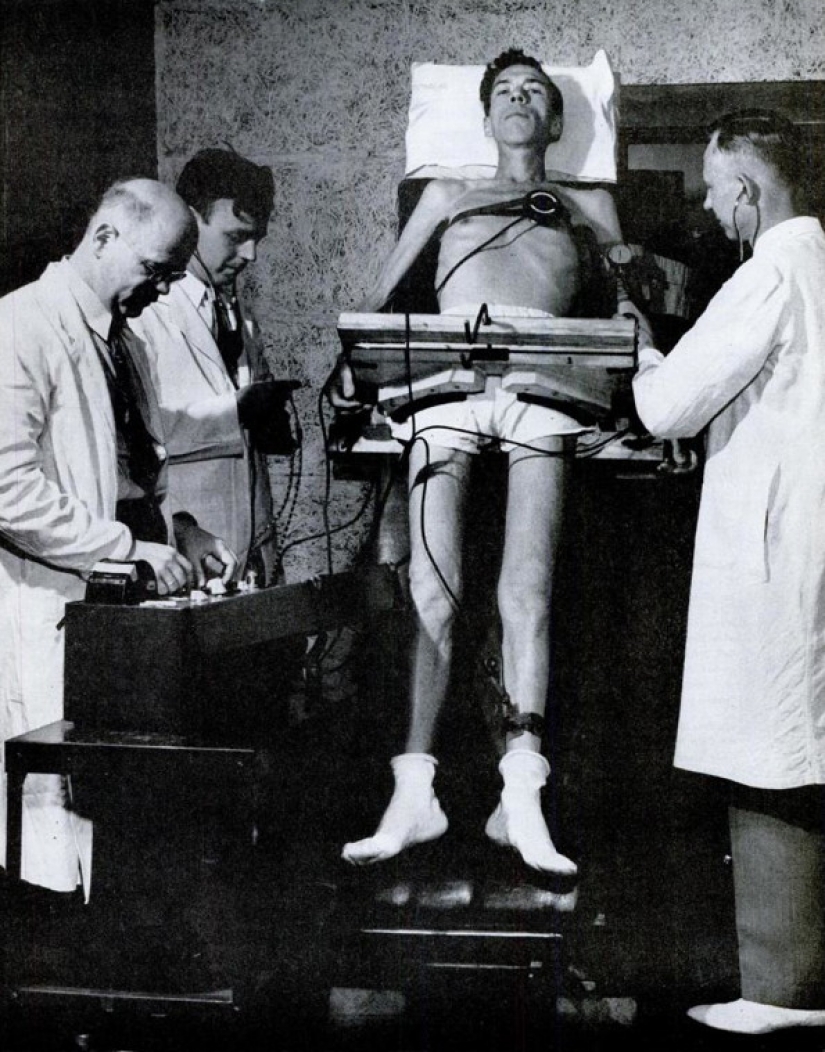 From a male point of view, the most uncomfortable physiological change was the absence of subcutaneous fat. Participants in the experiment could not sit on a hard surface, as this gave them a terrible discomfort. Moreover, they are constantly cold.
From a male point of view, the most uncomfortable physiological change was the absence of subcutaneous fat. Participants in the experiment could not sit on a hard surface, as this gave them a terrible discomfort. Moreover, they are constantly cold.
KIS also noticed that young people have vision after a long period of starvation remained the norm, and hearing, surprisingly, has improved significantly.
Despite physiological changes, the subjects did not consider himself too thin. They, on the contrary, began to seem that it is a other participants of the experiment are thick, but they are normal. Such thoughts characteristic of patients with anorexia.
 Dan Miller during the fasting period and after
Dan Miller during the fasting period and after
The rehabilitation period
After six months of starvation, the subjects lost almost a quarter of her body weight. Their average weight was 52 kg.
The rehabilitation period started on July 29, 1945. All subjects KIS were divided into four subgroups, which now began to 400, 800, 1200 or 1600 calories more than during fasting. He did this in order to determine the optimum amount of calories that should be consumed during the recovery period.
Some members of KIS were given vitamin and protein supplements to see how it will affect rehabilitation. Few weeks it has become clear that they are absolutely useless. Moreover, men who consumed the least amount of calories was not restored at all. In the end, Kitty came to the conclusion that in order to return the body to normal condition, you should consume about 4000 calories per day.
The end of the experiment
"Hungry" experiment ended on 20 October 1945. Young people can now have everything they want. Some of them KIS were asked to stay in the lab for a couple of months in order to observe them during the "unlimited period of rehabilitation." He noticed that the young people began to consume on average more than 5,000 calories a day. Within a few months they said that can't satisfy the hunger, no matter how much they ate.
A full report on the experiment and its results Ancel Keys published in 1950. It was a huge two-volume work entitled "the Biology of human starvation." To this day it remains the most comprehensive scientific study of the effects of starvation.
The report Kisa much attention is paid to how much changes our physical and mental state is influenced by lack of food. Nevertheless, the results of the experiment also showed that hunger is not having any significant and lasting negative impact on human health.
Keywords: The second World war | Hunger | Diet | The United States | Scientists | Experiment
Post News ArticleRecent articles

The fate of peasant women in Rus' has never been simple. Husband violence was common in families. A husband could beat his wife ...

If you have a couple of old jeans lying around at home, which it's time to "retire" for a long time, do not rush to throw them ...
Related articles

A dream of a beautiful figure, but can't take myself in hand and, finally, to abandon all of these chocolates, sweets, biscuits and ...

Despite the fact that the world is full of starving people, every year the inhabitants of our planet emit not less than 1.3 billion ...

Time magazine has compiled a list of ten foods that cause the greatest damage to the cardiovascular system. As luck would have it, ...

On Pikabu, a user nicknamed BootSect told how in 2007, together with his classmates, he played a prank on a history teacher at ...